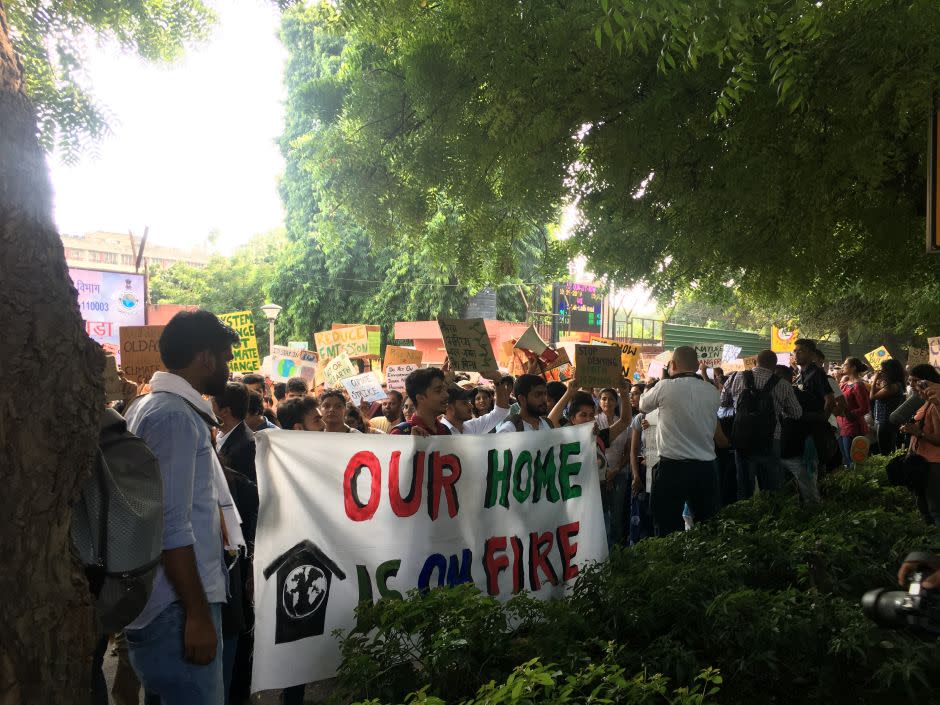India joins the global climate change strike

Indians are showing their solidarity with the ongoing global climate strike.
Today (Sept. 20), people across Delhi, Mumbai, Bengaluru and Kolkata, among other big cities, staged peaceful protests at prominent city centers, heeding Swedish climate activist Greta Thunberg’s call for mass protests to sound the alarm on climate change.
Extinction Rebellion, a climate change group, and Thunberg’s Fridays for Future are striking across the world between Sept. 20 and 27, asking governments to declare a climate change emergency and take definitive action.
In India, the movement is still fledgling. New Delhi’s millennials got together near Lodhi Garden, a landmark in Lutyens’ Delhi, to chant slogans that Thunberg and others popularised in Europe. They then marched to the nearby Ministry of Environment, Forests and Climate Change, where the police halted them. The young climate-change activists sat down on the street, sloganeering and rejoicing in the collective spirit of this movement.
“We are unstoppable, another world is possible,” shouted one group. Another group of about 10 people chanted, “What do we want? Climate Justice! When do we want it? Now!” A faction cheered on, “There’s no Planet B!” In a direct call to deniers, some also shouted, “Climate change is not a lie, we won’t let our planet die.” This is also a direct indictment of prime minister Narendra Modi’s feeble attempt to blame climate change on aged people’s sensitivity to heat or cold.

There was also one young man with a microphone using variants of the “Azaadi” (freedom) slogan, made popular by Jawaharlal Nehru University’s Kanhaiyya Kumar, and later, by Bollywood film Gully Boy. The protesters didn’t have a dedicated podium for speakers, and, according to the police at the venue, neither did they have the permission to protest.
Through this week, several protests will be held across major Indian cities.
A protest story
India has a vibrant culture of street plays and folk music and several young men and women carried tambourines to add music to rebellion. Smartly-dressed students, young women in artsy saris and silver jewellery, and young men in long kurtas and chappals were everywhere.
Nehmat Gill, one of the handful of students in a school uniform, was disappointed that there weren’t enough students. “I feel parents are not aware or worried about their children’s future and aren’t aware of these strikes,” said the 16-year-old student from Delhi Public School, Noida. In other parts of the world, children and young adults have been at the forefront of Thunberg’s Friday strikes. In India, though, parents often worry about their child’s security. “My parents, though, were very pleased. Plus, I’m here with a friend, so that’s reassuring for them,” said Gill.

Striking.
But what purpose does her presence at a protest like this serve? “I think it’s for all those people who think it’s just 2 degrees (the increase in global warming). But strikes like these tell people the impact just 2 degrees can have on glaciers,” she said. She also felt that Modi needed to hear from children to set climate change as his priority. “Things like demonetisation can happen later! But Earth phatt jaayega toh kya karoge (if things go spectacularly wrong then what will you do)?” said the vociferous teenager.
Slightly older young adults are more skeptical about displaying passion. “I don’t see a concrete plan or demands that this group has of the government. It’s great to build a community, but we’re all just here to see what it is,” said Chhavi Mathur, a 20-year-old student. Her friend, Anushka Kale, a resident of Bengaluru, accompanied her to experience her first protest in Delhi. “I feel there isn’t enough diversity and the crowd here is pretty elite,” she said. “The thing is, climate change impacts everyone! But this is typical of environmental protests in the city,” said Kale.
Concrete measures
Beyond walk-ins, the protest also saw participation from seasoned environmental activists. Bittu KR, an assistant professor of biology at Ashoka University, was one such participant. He said that Indian environmentalists, though diverse and often working independently, have concrete policy demands from the government. “We want the government to work towards reducing emissions and deforestation. Merely setting up an afforestation fund that rarely gets utilised is not enough. Neither is afforestation that, in turn, only plants monoculture trees,” he said.

No Planet B.
While young students may not be as articulate as Bittu, he felt that the number of eager participants at such protests is rising. “As the carbon dioxide levels increase, so does the number of people rebelling against it,” he quipped.
Sharique Khan, a 17-year-old student from Jaypee Public School in Greater Noida, is certainly one of them. He bunked an exam to attend the strike, much like what Thunberg’s Fridays for Future wants its young volunteers to do. His school principal, he said, was happy to allow him to take the exam at a later date.
While the protests are still gentle, the same group also organised a more forceful protest outside the Ministry of Housing and Urban Affairs in New Delhi. A large effigy of Ravana, the villain who represents evil in the Hindu epic Ramayana, was carried outside the ministry to symbolise the demon that is climate change.
A few children also went inside to meet Hardeep Singh Puri, also India’s civil aviation minister, who later tweeted about it.
The future is in safe hands.
I had a wonderful meeting with a delegation of young new Indians who totally impressed me with their concern for the environment & issues related to climate change. pic.twitter.com/FnrAPQFsEB
— Hardeep Singh Puri (@HardeepSPuri) September 20, 2019
Sign up for the Quartz Daily Brief, our free daily newsletter with the world’s most important and interesting news.
More stories from Quartz:

